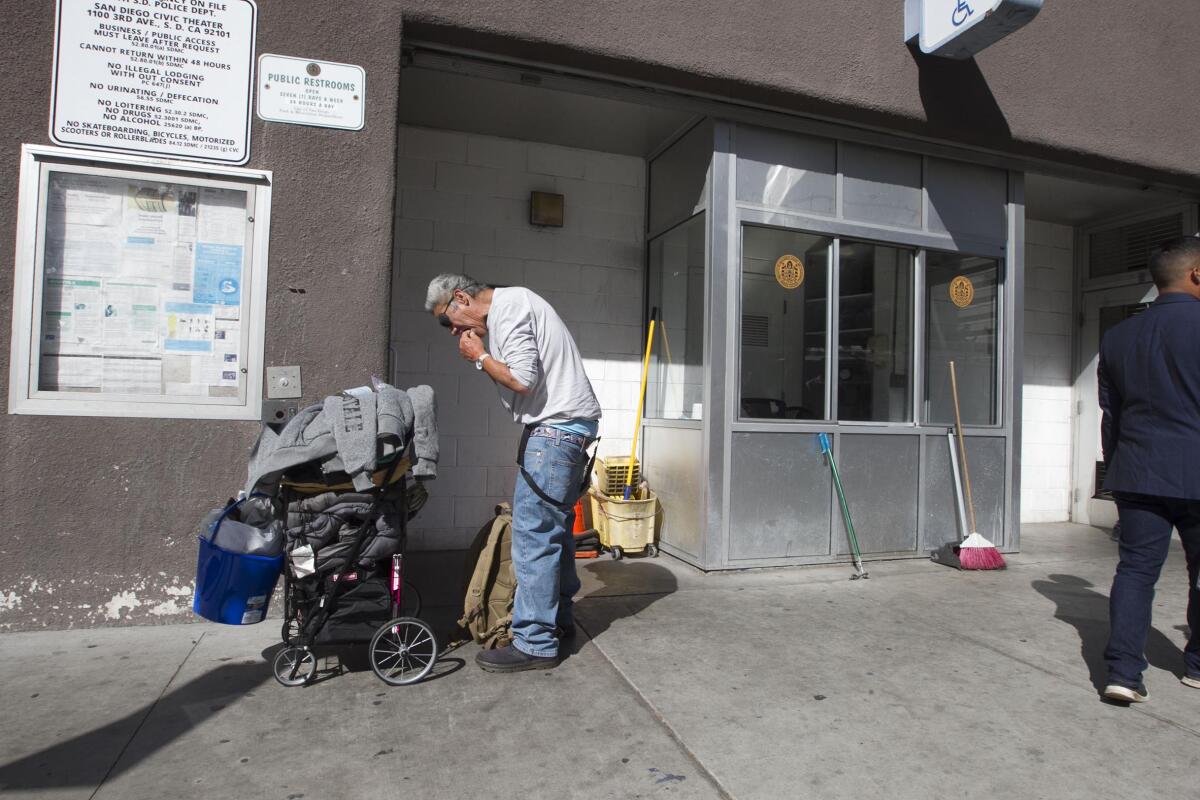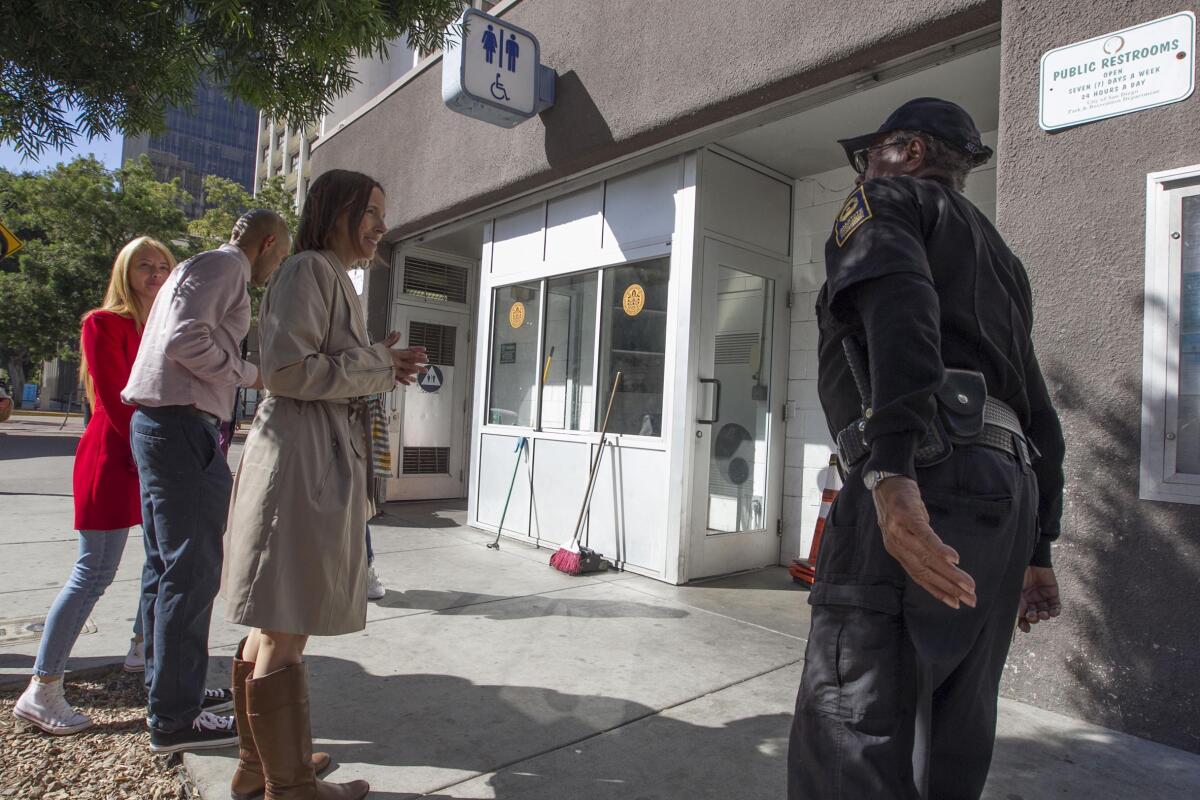Could charging for public restrooms help San Diego cope with downtown’s homelessness crisis?

- Share via
SAN DIEGO — San Diego city leaders want the state to lift a nearly 50-year-old ban on pay toilets, which they say could solve a shortage of clean and safe downtown restrooms that repels tourists and puts homeless people’s health at risk.
The city could afford to install and operate many more secure and well-lighted restrooms across downtown and in other pedestrian-oriented neighborhoods if it could cover some of its costs by charging each user a nominal fee, leaders say.
This story is for subscribers
We offer subscribers exclusive access to our best journalism.
Thank you for your support.
Some critics say it would be cruel and inhumane to charge homeless people for the right to use a restroom, but city officials say homeless people would be better off, because there would be so many more clean and safe public restrooms.
“This is not meant to be a barrier to access, but to actually increase the number of restrooms that we have out there,” City Council President Sean Elo-Rivera said. “We’ve heard from multiple people in the community that they would gladly pay a quarter or 50 cents for access to a clean restroom.”
Reactions to Elo-Rivera’s proposal from local homeless advocates and downtown leaders have been mixed.
Many say they see the logic behind charging fees so that the city can afford to open more restrooms, but some expressed concern that people might urinate and defecate on the streets more often if restrooms cost money.
Elo-Rivera’s proposal was unanimously endorsed last month by the City Council, which added overturning the state ban on pay toilets to the city’s Sacramento lobbying priorities for 2023.
The state ban specifically prohibits cities from charging fees to help cover the costs of operating public restrooms, so the council voted to “support legislation that allows local jurisdictions to implement cost-recovery measures for public bathroom access.”
California was part of a national movement in the 1970s that prompted more than a dozen states to ban pay toilets. That push was led by a group called the Committee to End Pay Toilets in America, which said access to free restrooms should be a basic human right.
The group also complained that pay toilets were sexist because at the time many of them charged for use of stalls while making use of urinals free.
“The initial efforts to ban any cost recovery were well-intended, but the result has been there are fewer and fewer and fewer public restrooms, and there are really big public health impacts as a result,” Elo-Rivera said. “We’re not providing the level of dignity that folks in our community deserve.”

City officials stress that lifting the state ban wouldn’t automatically prompt a wave of pay toilets across California. It would simply give cities, especially large cities struggling with homelessness, the discretion to experiment with pay toilets.
New York State recently amended its ban on pay toilets to exempt New York City, where five pay toilets are now operating. And pay toilets are common in European cities.
San Diego officials also stress that the city wouldn’t be required to charge fees high enough to cover the entire cost of operating the restrooms.
They could charge small fees, and any revenue generated would help defray some of the city’s costs and allow it to afford to operate more public restrooms. Homeless people could also possibly be given special tokens to let them use the restrooms for free.
City officials say it now costs about $30,000 a month to operate portable toilets when security and lighting are included.
While costs vary for permanent toilets based on location, amenities and other factors, city officials say they typically cost about $250,000 to install and require maintenance and security costs similar to portable toilets.
“The costs associated with providing the level of access to restrooms that we might seek can really add up,” Elo-Rivera said.
Mayor Todd Gloria said in 2021 that San Diego was committed to having a clean and safe public restroom within a quarter-mile — roughly a five-minute walk — of any location downtown.
But a study released last month by San Diego State University shows there aren’t nearly enough restrooms to fulfill that pledge. There are only two 24-hour public restrooms downtown, with most of the area’s 20 other public restrooms operating about 10 hours per day.
San Diego’s lack of downtown restrooms has been highlighted by four county grand jury reports. It has also been blamed for the hepatitis A outbreak in 2017, which killed 20 and sickened 582 more, and a 2021 outbreak of Shigella that infected more than 45 people.
San Diego’s prospects for overturning the state ban on pay toilets are unclear, said Adrian Granda, who oversees the city’s lobbyists as the mayor’s director of government affairs.
Granda said there doesn’t appear to have been any previous or ongoing attempts to overturn California’s ban, which leaves San Diego at square one.
The city could sponsor its own legislation, but he said it’s too early to determine whether that will be the city’s course.
Persuading other cities and powerful state officials to support overturning the pay toilet ban will take some effort, Granda said.
“It’s a pretty novel concept,” he said, referring to the idea of helping homeless people by charging them for restroom use. “It’s kind of counterintuitive.”
Bob McElroy, a homeless advocate who runs the nonprofit Alpha Project, agreed that the proposal simultaneously raised concerns and had some merit.
“I can see the logic behind it, and maybe it’s a smart move,” he said. “Generating revenue for more restrooms makes sense, but that’s not going to fly with the homeless population.”
McElroy said many homeless people have no money on them at all.
“If they have to go and they don’t have 25 cents, they’re just going to go where they normally do — not in a restroom,” he said.
Michael McConnell, another homeless advocate and a vocal critic of many city homelessness policies, was also conflicted.
“I can see both sides,” he said. “If you charged, people wouldn’t camp out inside restrooms as often, and there would be many more clean and safe restrooms. But it would kind of suck if somebody’s got to go and they can’t because they can’t pay.”
Michael Trimble, executive director of the Gaslamp Quarter Association, said he thinks pay toilets might be a good idea.
“It makes sense to me that a homeless person would want dignity over peeing in the street,” he said.
Trimble, whose group has lobbied for more security at some downtown restrooms, said some of them have become havens for drug use and other crime — and a deterrent to customers.
If the city has more revenue, they can make the public restrooms safer and more orderly, he said.
Mitchelle Woodson, executive director of the homeless advocacy group Think Dignity, strongly objected to the idea of pay toilets.
“This is ridiculous — I’m against any charge for a basic human need,” said Woodson, whose group helped coordinate the recent SDSU restroom study. “I’d be against it whether it’s 25 cents or $25.”
Woodson said that the downtown restroom problem was caused by decades of city negligence and that the solution is not to start charging homeless people for restroom use.
She said the city should pay for an adequate number of clean and safe restrooms downtown and stop complaining about the costs, contending the city will save money it’s now spending on “reactive” efforts to cope with homelessness and public health problems.
A new session of the state Legislature just began. Proposed legislation, which must work its way through a complicated committee system, typically must be approved by both the Assembly and Senate by September to become law the following January.
More to Read
Sign up for Essential California
The most important California stories and recommendations in your inbox every morning.
You may occasionally receive promotional content from the Los Angeles Times.














